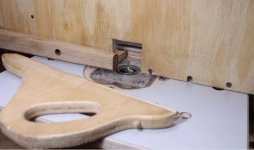Toolpig
Member
- Joined
- Jan 25, 2007
- Messages
- 399
Thanks for the kind words. I can't imaging having to joint with my thickness planer, but it's something I'm considering trying. The jointer is just so damn convenient for that. As for edge jointing, I am playing around with other options like hand planes and my router table. Who knows, I might sell the jointer at some point.
Joelm said:First of all, thanks for sharing your story and I'm glad you are back in the shop so soon.
Your video is the 4th or 5th I've seen regarding jointer accidents. This has totally turned me off of buying one. I like woodworking as a hobby but I also like waving to people with all my fingers.
For my case I tried the sled with a planner alternative. This worked just fine for face jointing but is definitely a longer process.
I've also bought a handful of Lee Valley planes including a scrub plane. I find using a scrub plane to roughly flatten a face before planning the other side works quite well. For edge jointing I've been using a Lee Valley #6. I'd like to get their BU #7 soon as it is longer. Hand planes are new to me but I definitely like using them even though they are way slower than using a machine. Myself I prefer the joy of using hand tools on projects but that's just my preference.
I've also wondered why no one seems to use a power feeder in the jointer. Seems much safer and the wheels can be oriented horizontal or vertical.
Thanks again for sharing and I hope that's your last serious accident.

